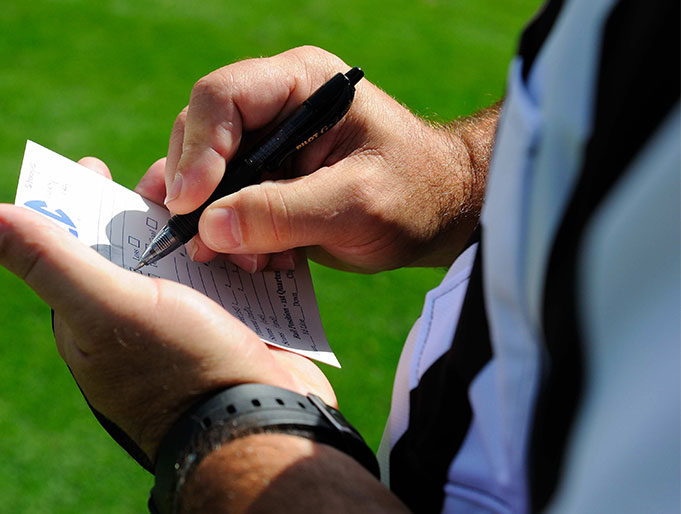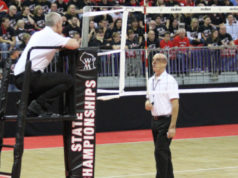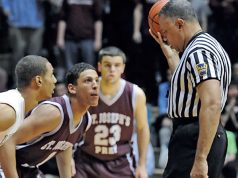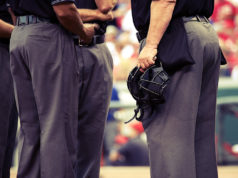Officials can develop healthy habits that have nothing to do with streamlining their diet or counting calories. Many sports have repeated practices or habits that you can rehearse in preparation for games. Here are some tips to help you learn good habits and ways to practice the practices — if not to make them perfect, at least to polish their luster.
Baseball & Softball
Let’s begin with the difficult practice of calling balls and strikes. All we need is a pitcher and a catcher, and they don’t have to be regular players, either. Anyone who can toss an object will do. Put something on the floor of your living room or out in the driveway to simulate home plate and go to work. It’ll help to have a pretend batter too, one who’ll never swing at a pitch.
Crouch down behind the catcher and have the pitcher throw a wad of paper, a wiffle ball, anything that flies reasonably straight. Then make your calls, over and over. Have someone critique your stance, your reactions and your judgment.
Of course, it’ll help if real players pour in real pitches. Set-ups like that scene, though, can be part of association meetings, several dozen members going at once: pitcher, catcher and phantom hitter. Umpires themselves can take turns being the players and other umpires can umpire. Chances are, such practice will lead to steady improvement.
One of the hardest plays to cover in baseball or softball is a sharp hit to the outfield with runners on base. The difficult part is the spread of the field and the shortage of officials. That is, a ball may be hit so hard that one umpire must dash to the outfield to see whether a ball is caught on the fly. The home plate umpire can help, but must know how to help — when to move out from behind the plate, what base to cover and where to go for a subsequent play. All those moves can be practiced: Put runners on bases and fungo the ball out there, then rehearse the necessary adjustments.
Umpires can also work on calls at first base. Have someone hit infield grounders, let runners run and have umpires make the call at first base over and over. Hit shots down the foul line and have umpires make the fair or foul call. All elementary phases of baseball and softball can be simulated on a field — makeshift or real — so that umpires can practice and refine positioning and judgment.
Basketball
To make a similar system work in basketball you almost need an actual court. Set up a one-on-one situation, just like players do when they’re working on their skills, and have officials practice calling fouls (as well as traveling and other ballhandling violations). Again, people critiquing can be beneficial and so can using skilled or semi-skilled players. Many coaches would permit a corps of officials to come to a workout and referee one-on-one drills. Everybody involved would gain something, including players who’d obtain a good notion of what rights and restrictions they have.
Practice reporting fouls to the scorer’s table too. Practice hopping between players to forestall animosities after hard fouls. Practice getting the good angle on driving shooters so that you can view contact accurately.
Football
Officials don’t need a real football team and needn’t be outdoors. You don’t even need a real ball. A Nerf ball will work just fine. Put a couple of pretend linemen, a snapper and a quarterback in an offensive alignment. Have the linemen commit a variety of false starts: quick head tilts, body leans and sudden “lift-ups.” Officials have to react with flags, whistles and stop-the-clock signals. Teach flag-tossing techniques. Emphasize killing the clock.
In real life, many officials neglect to kill the clock on false starts and encroachment.
Have the ersatz quarterback engage in some machinations also, such as illegal head bobs, shoulder hunches and arm thrusts under the snapper. Another quarterback illegality is a no-pause silent count or “touch” signal. Many officials miss that foul, and it gives the team on offense a distinct edge in running a short-yardage play. It would be good to practice detecting that act.
Soccer
Officials can study certain aspects of soccer rules at meetings with the help of a piece of carpet, perhaps six feet square, painted with the correct dimensions for half a field. Game situations can be illustrated by using colored coasters as players and moving them about on the “field.”
It is easier to set the wall on free kicks if referees can learn to judge the 10 yards by sight rather than stepping it off. That skill can be learned in the backyard or an unoccupied soccer field. With practice, the referee can learn to run immediately to a spot level with the location where the 10 yards end and then move the wall back by voice (all the while remembering to keep the ball in sight).
Philosophy
There are many fundamental judgments officials must make that can be practiced. What to practice, however, may require you to establish a personal philosophy on a type of situation, or adhere to a policy mutually agreed to by the members of your association.
Take for instance the choice of whether or not to put hands on players. When football players are fighting over a fumble or basketball players entangled going for a loose ball, officials generally feel it their duty to peel them off. Some pro officials pry players apart when they’re upright also. “It’s the one time we put hands on players,” an NFL referee testified. You or your association should adopt a policy about that. “Players don’t really want to hit us,” that NFL person added.
If you are uncomfortable about pushing players with your hands, try stepping between them and shouldering them out of the way. That can be a deliberately chosen technique you personally prefer, or a policy your association has decided to teach to all the members of your association.
Whatever you decide your go-to approach will be in a situation, try it in a make-believe setting.
You can also rehearse verbal interactions that happen with regularity. You can practice addressing the individual that you feel is at fault or who needs direct counseling. Try to do it without pointing your finger and with a straightforward order, meaning don’t tip your head backward or thrust it in the aggressor’s face.
The thing about officiating habits is that they are sometimes embraced incorrectly in the first place, and then one has a hard time unlearning them. Once acquired, habits continue unabated, reinforcing themselves, if no one obliges us to adjust. They’ll never change unless some interceptive force stimulates a change. Many an astonished official has declared, “I never knew I did that!” after seeing a video of a game he worked.
Lastly, only a closed mind will deny the possibility of refining old habits or acquiring ones that are new and improved. Getting out of a rut can be exhilarating. When you help other practice, seeing that you helped them abandon a detrimental customary behavior can be equally satisfying as breaking a bad habit of your own.
What's Your Call? Leave a Comment:
Note: This article is archival in nature. Rules, interpretations, mechanics, philosophies and other information may or may not be correct for the current year.
This article is the copyright of ©Referee Enterprises, Inc., and may not be republished in whole or in part online, in print or in any capacity without expressed written permission from Referee. The article is made available for educational use by individuals.

















